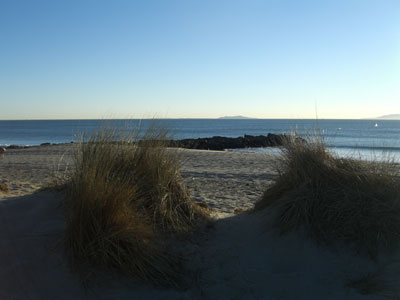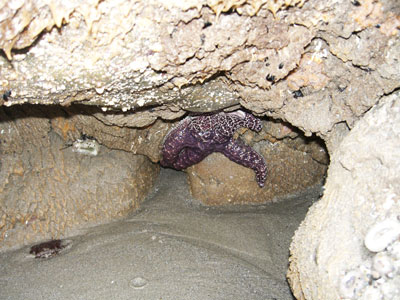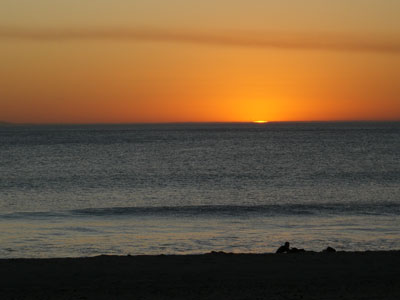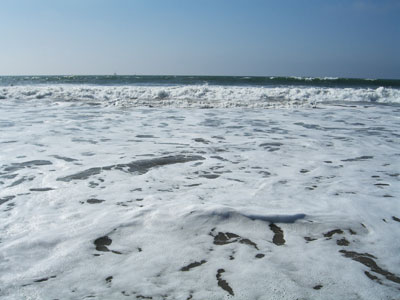The Ocean...

Pierpont Sand Dunes, Ventura, CA, 2009 (Photo: K.Anderberg)
"Winds are advertisements of all they touch, however much or little we may be able to read them: telling their wanderings even by their scents alone. Mariners detect the flowery perfume of land-winds far at sea, and sea-winds carry the fragrance of dulse and tangle far inland, where it is quickly recognized, though mingled with the scents of a thousand land-flowers." - John Muir, 1894
"Contemplating the teeming life of the shore, we have an uneasy sense of the communication of some universal truth that lies just beyond our grasp. What is the message signaled by the hordes of diatoms, flashing their microscopic lights in the night sea? What truth is expressed by the legions of the barnacles, whitening the rocks with their habitations, each small creature within finding the necessities of its existence in the sweep of the surf? And what is the meaning of so many tiny a being in the transparent wisp of protoplasm that is a sea lace, existing for some reason inscrutable to us - a reason that demands its presence by the trillion amid the rocks and weeds of the shore? The meaning haunts and ever eludes us, and in its very pursuit we approach the ultimate mystery of Life itself." - Rachel Carson, 1955

Purple starfish (and small crab in lower left of pic) in cave on Ventura Beach, 2009 (Photo: K.Anderberg)
"The shore has a dual nature, changing with the swing of the tides, belonging now to the land, now to the sea. On the ebb tide it knows the harsh extremes of the land world, being exposed to heat
and cold, to wind, to rain, to drying sun. On the flood tide it is a water world, returning briefly to the relative stability of the open sea. Only the most hardy and adaptable can survive
in a region so mutable, yet the area between the tide lines is crowded with plants and animals." - Rachel Carson

Sunset on Ventura Beach, 2009 (Photo: K.Anderberg)
"To qualify as an estuary, a body of water must be well enclosed, provide easy entry and exit for open sea water and enjoy a vigorous infusion of fresh water from
one or more rivers. These are minimum requirements. The fiords of Norway are estuaries, but they are uniformly rocky, deep and thus biologically impoverished, which is why Norwegian
fishermen spend most of their time on offshore banks. A good estuary with high biological productivity requires other things. Shallow water, for one, which the sun can penetrate and nourish
with both plankton and rooted aquatic plants. Extensive marshland is another. An estuary without it lacks the lace-work of tidal creeks and shallow coves which traps nutrients and protects
and feeds the larvae and juveniles of a host of fish and invertibrates.
Also, to be summa cum laude in estuarine productivity, there must be circulation. A good mix, one is tempted to say,
is almost everything. Not just in one direction. There should be two-layered or horizontal circulation in which heavier salt from the ocean slides under the lighter and fresher surface water
from rivers. Inexorably, that is, with a new flow upstream on the bottom and downstream on the top which surmounts the temporary effects of wind and tide. Ideally, there should also
be some vertical mixing, which is not found in every estuary, since it requires significant contrasts in depths and water temperatures." - William Warner, Beautiful Swimmers

Ocean Froth in Ventura, CA, 2009 (Photo: K.Anderberg)
"The shore is an ancient world, for so long as there has been an earth and sea there has been this place of the meeting of land and water…Whenever I go down into this magical zone of the low water of the spring tides, I look for the most delicately beautiful of all the shore's inhabitants - flowers that are not plant but animal, blooming on the threshold of the deeper sea. In that fairy cave I was not disappointed. Hanging from its roof were the pendent flowers of the hydroid Tubularia, pale pink, fringed and delicate as the wind flower. Here were creatures so exquisitely fashioned that they seemed unreal, their beauty too fragile to exist in a world of crushing force. Yet every detail was functionally useful, every stalk and hydranth and petal-like tentacle fashioned for dealing with the realities of existence. I knew that they were merely waiting, in that moment of the tide's ebbing, for the return of the sea. Then in the rush of water, in the surge of surf and the pressure of the incoming tide, the delicate flower heads would stir with life. They would sway on their slender stalks, and their long tentacles would sweep the returning water, finding in it all that they needed for life…I was filled with awareness that this intertidal area, although abandoned briefly and rhythmically by the sea, is always reclaimed by the rising tide." - Rachel Carson, 1955

Pierpont Sand Dunes, Ventura, CA, 2009 (Photo: K.Anderberg)
"Winds are advertisements of all they touch, however much or little we may be able to read them: telling their wanderings even by their scents alone. Mariners detect the flowery perfume of land-winds far at sea, and sea-winds carry the fragrance of dulse and tangle far inland, where it is quickly recognized, though mingled with the scents of a thousand land-flowers." - John Muir, 1894
"Contemplating the teeming life of the shore, we have an uneasy sense of the communication of some universal truth that lies just beyond our grasp. What is the message signaled by the hordes of diatoms, flashing their microscopic lights in the night sea? What truth is expressed by the legions of the barnacles, whitening the rocks with their habitations, each small creature within finding the necessities of its existence in the sweep of the surf? And what is the meaning of so many tiny a being in the transparent wisp of protoplasm that is a sea lace, existing for some reason inscrutable to us - a reason that demands its presence by the trillion amid the rocks and weeds of the shore? The meaning haunts and ever eludes us, and in its very pursuit we approach the ultimate mystery of Life itself." - Rachel Carson, 1955

Purple starfish (and small crab in lower left of pic) in cave on Ventura Beach, 2009 (Photo: K.Anderberg)
"The shore has a dual nature, changing with the swing of the tides, belonging now to the land, now to the sea. On the ebb tide it knows the harsh extremes of the land world, being exposed to heat and cold, to wind, to rain, to drying sun. On the flood tide it is a water world, returning briefly to the relative stability of the open sea. Only the most hardy and adaptable can survive in a region so mutable, yet the area between the tide lines is crowded with plants and animals." - Rachel Carson

Sunset on Ventura Beach, 2009 (Photo: K.Anderberg)
"To qualify as an estuary, a body of water must be well enclosed, provide easy entry and exit for open sea water and enjoy a vigorous infusion of fresh water from one or more rivers. These are minimum requirements. The fiords of Norway are estuaries, but they are uniformly rocky, deep and thus biologically impoverished, which is why Norwegian fishermen spend most of their time on offshore banks. A good estuary with high biological productivity requires other things. Shallow water, for one, which the sun can penetrate and nourish with both plankton and rooted aquatic plants. Extensive marshland is another. An estuary without it lacks the lace-work of tidal creeks and shallow coves which traps nutrients and protects and feeds the larvae and juveniles of a host of fish and invertibrates.
Also, to be summa cum laude in estuarine productivity, there must be circulation. A good mix, one is tempted to say, is almost everything. Not just in one direction. There should be two-layered or horizontal circulation in which heavier salt from the ocean slides under the lighter and fresher surface water from rivers. Inexorably, that is, with a new flow upstream on the bottom and downstream on the top which surmounts the temporary effects of wind and tide. Ideally, there should also be some vertical mixing, which is not found in every estuary, since it requires significant contrasts in depths and water temperatures." - William Warner, Beautiful Swimmers

Ocean Froth in Ventura, CA, 2009 (Photo: K.Anderberg)
"The shore is an ancient world, for so long as there has been an earth and sea there has been this place of the meeting of land and water…Whenever I go down into this magical zone of the low water of the spring tides, I look for the most delicately beautiful of all the shore's inhabitants - flowers that are not plant but animal, blooming on the threshold of the deeper sea. In that fairy cave I was not disappointed. Hanging from its roof were the pendent flowers of the hydroid Tubularia, pale pink, fringed and delicate as the wind flower. Here were creatures so exquisitely fashioned that they seemed unreal, their beauty too fragile to exist in a world of crushing force. Yet every detail was functionally useful, every stalk and hydranth and petal-like tentacle fashioned for dealing with the realities of existence. I knew that they were merely waiting, in that moment of the tide's ebbing, for the return of the sea. Then in the rush of water, in the surge of surf and the pressure of the incoming tide, the delicate flower heads would stir with life. They would sway on their slender stalks, and their long tentacles would sweep the returning water, finding in it all that they needed for life…I was filled with awareness that this intertidal area, although abandoned briefly and rhythmically by the sea, is always reclaimed by the rising tide." - Rachel Carson, 1955